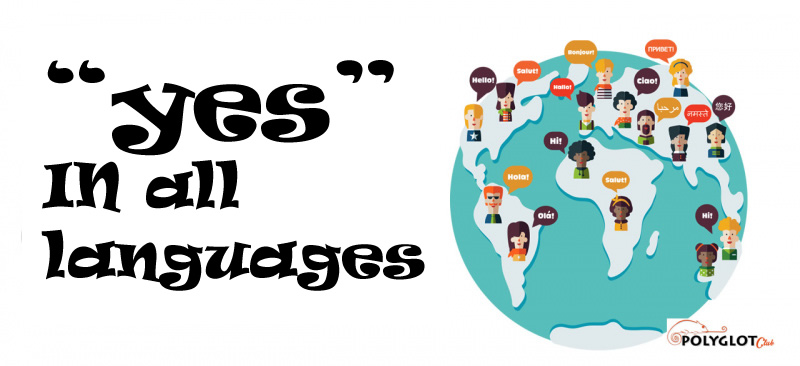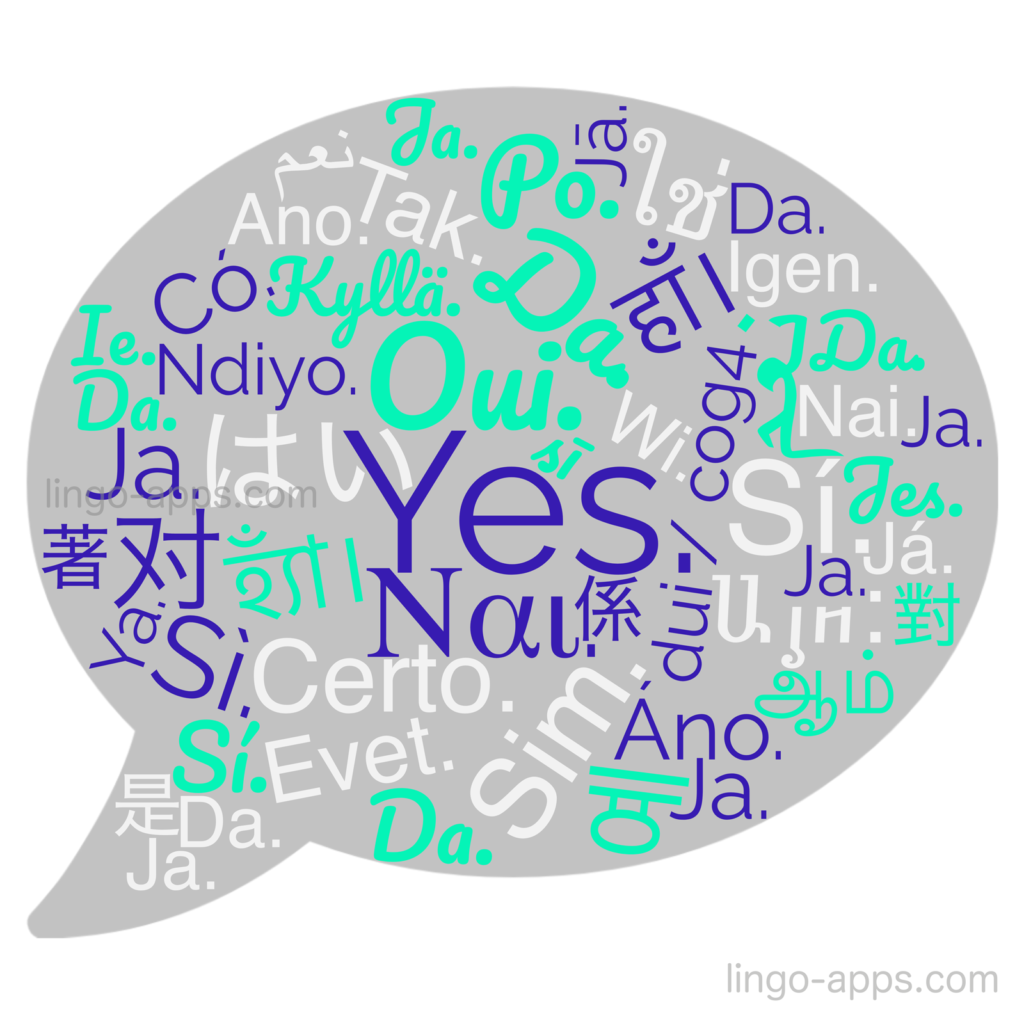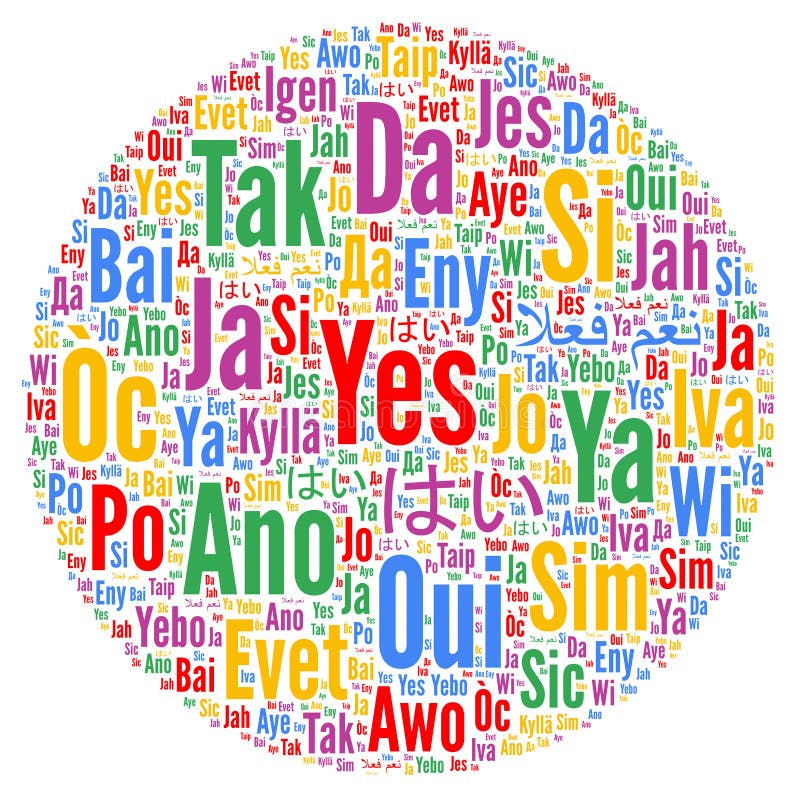Yes in all languages – Yes, a seemingly simple word, carries a multitude of nuances and variations across languages. From the familiar “sí” in Spanish to the subtle nod in Japanese, the expression of agreement takes on diverse forms worldwide. This comprehensive guide delves into the fascinating world of “yes” in all languages, exploring its cultural implications, variations, and the role it plays in effective communication.
As we embark on this linguistic journey, we will uncover the intricate tapestry of human expression, revealing the hidden meanings and social cues embedded within this ubiquitous word.
Languages with Similar Pronunciation to ‘Yes’

Across various languages, there are words that share a similar pronunciation to the English word ‘yes’. This table presents a list of languages with words that sound similar to ‘yes’ and their corresponding pronunciations:
| Language | Word | Pronunciation |
|---|---|---|
| Spanish | Sí | /si/ |
| Italian | Sì | /si/ |
| French | Oui | /wi/ |
| German | Ja | /ja/ |
Variations of ‘Yes’ in Different Languages

The word ‘yes’ is a universal affirmative response that transcends linguistic boundaries. However, its pronunciation and usage vary significantly across languages, reflecting cultural and historical influences.
Cross-Language Comparison
| Language | Variation | Pronunciation | Cultural Significance |
|---|---|---|---|
| English | Yes | /jɛs/ | Standard affirmative response |
| Spanish | Sí | /si/ | Formal and informal affirmative |
| French | Oui | /wi/ | Standard affirmative response |
| German | Ja | /ja/ | Standard affirmative response |
| Russian | Да | /da/ | Standard affirmative response |
| Mandarin Chinese | 是 | /ʃi/ | Standard affirmative response |
| Japanese | はい | /hai/ | Formal affirmative response |
| Korean | 네 | /ne/ | Informal affirmative response |
| Arabic | نعم | /naʕam/ | Standard affirmative response |
| Hindi | हाँ | /hã/ | Standard affirmative response |
Cultural Implications of ‘Yes’

The word “yes” is a simple and seemingly universal way to express agreement or affirmation. However, the cultural implications of saying “yes” can vary significantly across different languages and cultures.In some cultures, saying “yes” is considered a sign of politeness and respect.
For example, in Japanese culture, it is considered rude to say “no” directly. Instead, people will often use indirect language or phrases that convey agreement without explicitly saying “yes.”In other cultures, saying “yes” is seen as a more formal and serious matter.
For example, in many Western cultures, a “yes” is often seen as a binding agreement that cannot be easily broken. This can lead to misunderstandings in situations where people from different cultures are interacting.It is important to be aware of the cultural implications of saying “yes” in different languages and cultures.
This will help you to avoid misunderstandings and communicate more effectively with people from other cultures.
Politeness and Formality
In some cultures, saying “yes” is considered a sign of politeness and respect. For example, in Japanese culture, it is considered rude to say “no” directly. Instead, people will often use indirect language or phrases that convey agreement without explicitly saying “yes.”
This is because saying “no” can be seen as a challenge to the other person’s authority or status.In other cultures, saying “yes” is seen as a more formal and serious matter. For example, in many Western cultures, a “yes” is often seen as a binding agreement that cannot be easily broken.
This is because in these cultures, contracts and agreements are often based on the spoken word. As a result, it is important to be careful about saying “yes” in these cultures, as it can be difficult to back out of an agreement once it has been made.
Social Norms, Yes in all languages
The social norms surrounding saying “yes” can also vary across cultures. For example, in some cultures, it is considered impolite to say “no” to a request, even if you do not want to do it. This is because saying “no” can be seen as a sign of disrespect or disinterest.In
other cultures, it is more acceptable to say “no” to requests, even if you do not have a good reason. This is because in these cultures, people are more likely to value their own time and commitments.It is important to be aware of the social norms surrounding saying “yes” in different cultures.
This will help you to avoid misunderstandings and communicate more effectively with people from other cultures.
Non-Verbal Expressions of ‘Yes’
In addition to verbal affirmations, various non-verbal cues can convey agreement or affirmation across cultures. These gestures and body language signals provide insights into the speaker’s attitude and intentions, enhancing communication and fostering understanding.
Below is a list of common non-verbal expressions of ‘yes’ in different cultures:
Head Movements
- Nodding:In many Western cultures, a slight up-and-down movement of the head indicates agreement or affirmation. However, in some Eastern cultures, such as Japan, a more subtle nod may signify respect rather than a direct ‘yes.’
- Head Tilting:In certain cultures, such as India, tilting the head slightly to one side can convey understanding or agreement. This gesture may be accompanied by a raised eyebrow or a slight smile.
Facial Expressions
- Raised Eyebrows:Raising both eyebrows briefly can signal surprise, agreement, or acknowledgment. This expression is often used in combination with other non-verbal cues.
- Smiling:A genuine smile can convey warmth, friendliness, and agreement. However, it’s important to consider the cultural context, as smiles may have different meanings in different settings.
Hand Gestures
- Thumbs Up:Extending the thumb upwards is a widely recognized gesture of approval or agreement. This gesture is commonly used in Western cultures.
- Fist Pump:Raising a clenched fist and shaking it up and down can signify enthusiasm, agreement, or celebration. This gesture is often used in sports and other competitive environments.
Body Language
- Open Posture:Standing or sitting with an open and relaxed posture, with uncrossed arms and legs, can convey receptiveness and agreement. This posture creates a welcoming and non-confrontational atmosphere.
- Leaning Forward:Leaning slightly forward towards the speaker can indicate engagement, interest, and agreement. This gesture shows that the listener is paying attention and is receptive to the message.
False Cognates and ‘Yes’
In linguistics, false cognates are words that sound similar in different languages but have different meanings. False cognates can lead to misunderstandings when speakers of one language assume that a word in another language has the same meaning as a similar-sounding word in their own language.
There are many examples of false cognates involving the word “yes”. For instance, the Spanish word “si” sounds similar to the English word “yes”, but it actually means “if”. Similarly, the French word “oui” sounds similar to the English word “yes”, but it actually means “yes, but”.
Examples of False Cognates
- English: “yes” – Spanish: “si” (meaning: “if”)
- English: “yes” – French: “oui” (meaning: “yes, but”)
- English: “yes” – German: “ja” (meaning: “yes, but”)
- English: “yes” – Italian: “si” (meaning: “yes, but”)
- English: “yes” – Portuguese: “sim” (meaning: “yes, but”)
The Role of ‘Yes’ in Communication
In the intricate tapestry of human communication, ‘yes’ serves as an indispensable thread, weaving together the fabric of understanding, agreement, and social harmony. It transcends mere verbal affirmation, embodying a profound significance that shapes our interactions.
The utterance of ‘yes’ fulfills several crucial functions in effective communication:
- Confirming understanding:When we respond with ‘yes’, we signal that we have received and comprehended the message conveyed. This simple affirmation prevents misunderstandings and ensures that both parties are on the same page.
- Expressing agreement:‘Yes’ serves as an explicit indication of our concurrence with a proposal, opinion, or request. It conveys our willingness to comply, support, or accept what has been presented.
- Maintaining social harmony:In many cultures, saying ‘yes’ is considered a polite and respectful response, even when we may not fully agree. It helps maintain a sense of harmony and avoid conflict.
Cultural Variations in the Use of ‘Yes’
While ‘yes’ generally conveys a positive response across cultures, its usage and interpretation can vary subtly depending on the context and cultural norms.
- In some cultures,‘yes’ may imply a strong commitment or obligation, while in others, it may be a more casual expression of agreement.
- In certain contexts,‘yes’ can be used as a polite way of declining a request or offer, while in others, it may indicate enthusiastic acceptance.
Understanding these cultural nuances is essential for effective cross-cultural communication.
Conclusion: Yes In All Languages
In conclusion, “yes” is not merely a word but a multifaceted expression that reflects the rich diversity of human cultures and communication styles. Understanding its variations and cultural implications enables us to bridge linguistic barriers, foster cross-cultural understanding, and communicate effectively in a globalized world.
FAQ Explained
What are some common variations of “yes” in different languages?
Languages such as French, German, and Russian have multiple variations of “yes,” each with its own cultural and historical significance.
How does the cultural context influence the way “yes” is expressed?
In some cultures, saying “yes” directly may be considered impolite or confrontational, while in others, it is a sign of respect and agreement.
What are some non-verbal cues that can indicate agreement in different cultures?
Nodding, smiling, and making eye contact are common non-verbal cues that convey agreement in many cultures.